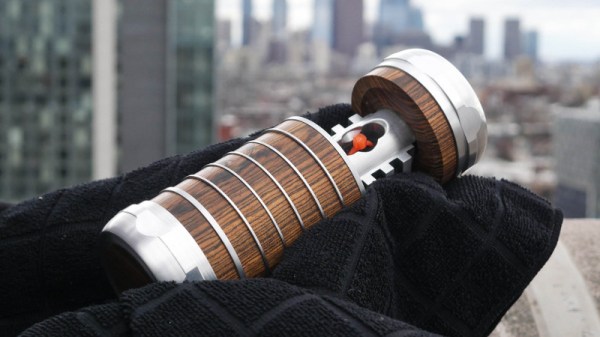Here’s a fun fact, the kind of thing that you might (but we definitely did not) find out when writing a blog post: Dan Brown actually made up the cryptex for his book, The Da Vinci Code. We therefore have Mr Brown, with a bit of help from the filmmakers over at Sony, to thank every time we see somebody make their own version. To follow that line of logic to its conclusion, we believe you’ll agree that the following is without question the greatest thing Dan Brown has ever done in his life.
Created by [Stephen Peduto] as a ring box for an exceptionally lucky young lady, it required an estimated 127 hours to complete over the course of two months. From the incredible job [Stephen] did photographing and documenting the build, we don’t doubt it for a second. Expertly combing milled aluminum and lathe-turned bocote wood, this has got to be the most gorgeous ring “box” ever made.
 Frankly, it’s hard to do justice to what [Stephen] has created in so short a space, and you really should browse through the 140+ images in his gallery. But the short version is that after some furious white board sketching, [Stephen] moved over to AutoCAD and then SolidWorks to design all the parts which would eventually get machined out of aluminum. As a very clever touch, he wisely added 17° slop in the locking mechanism so that the recipient wouldn’t fumble too much at the big moment.
Frankly, it’s hard to do justice to what [Stephen] has created in so short a space, and you really should browse through the 140+ images in his gallery. But the short version is that after some furious white board sketching, [Stephen] moved over to AutoCAD and then SolidWorks to design all the parts which would eventually get machined out of aluminum. As a very clever touch, he wisely added 17° slop in the locking mechanism so that the recipient wouldn’t fumble too much at the big moment.
When the machining was all said and done, [Stephen] then switched over to the woodworking part of the project. Rather than numbers or letters for a combination, this cryptex uses the grain pattern in the turned piece of wood. This gives the final product a more organic feel, while at the same time avoiding the head-scratching problem of getting the characters printed or engraved into the wheels.
Towards the end of construction there was a worrying moment when the newly made wooding rings warped so badly that the aluminum inserts would no longer fit. As a last resort, the rings were placed in a box with a humidifier for a week and slowly worked back into shape. [Stephen] says he’s still surprised it worked.
Even if some may argue that a cryptex is nothing but a prettied-up bike lock, people sure do love them. We’re no stranger to high quality cryptex builds here, though even mere mortals can play along if they’ve got a well calibrated 3D printer.




 We have to admit that we raised a wary eyebrow as we first watched [MakerMan]’s video below. We thought it was going to be just another hoverboard hack at first, but as we watched, there were some pretty impressive fabrication skills on display. Yes, the project does start with tearing into a defunct hoverboard for parts, primarily one wheel motor and the battery pack. But after that, [MakerMan] took off on a metalworking tear. Parts of the hoverboard chassis were attached to a frame built from solid bar stock — we’ll admit never having seen curves fabricated in quite that way before. The dead 18650 in the battery pack was identified and replaced, and a controller from an e-bike was wired up. Fitted with a thumb throttle and with a bit of padding on the crossbar, it’s almost a ride-upon but not quite. It seems to move along at quite a clip, even making allowances for the time-compression on the video.
We have to admit that we raised a wary eyebrow as we first watched [MakerMan]’s video below. We thought it was going to be just another hoverboard hack at first, but as we watched, there were some pretty impressive fabrication skills on display. Yes, the project does start with tearing into a defunct hoverboard for parts, primarily one wheel motor and the battery pack. But after that, [MakerMan] took off on a metalworking tear. Parts of the hoverboard chassis were attached to a frame built from solid bar stock — we’ll admit never having seen curves fabricated in quite that way before. The dead 18650 in the battery pack was identified and replaced, and a controller from an e-bike was wired up. Fitted with a thumb throttle and with a bit of padding on the crossbar, it’s almost a ride-upon but not quite. It seems to move along at quite a clip, even making allowances for the time-compression on the video.














